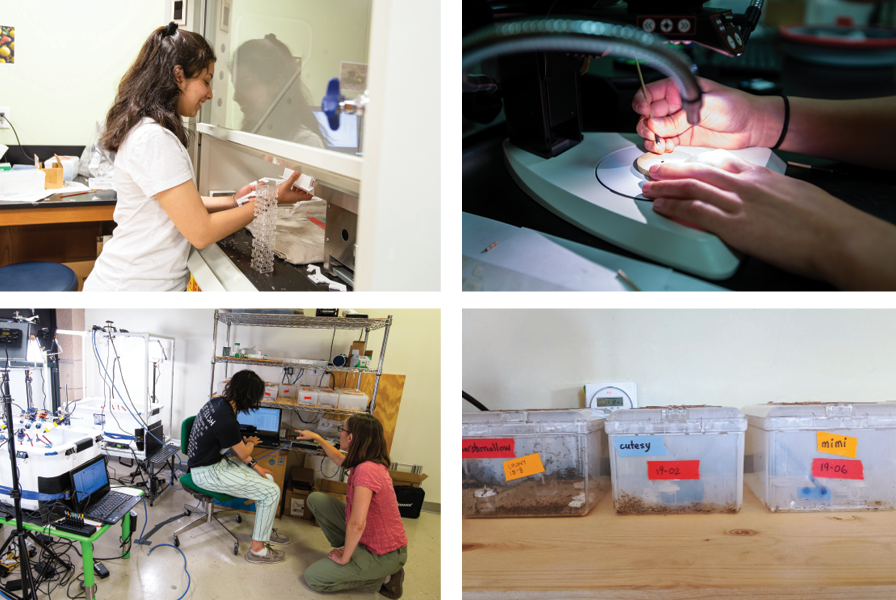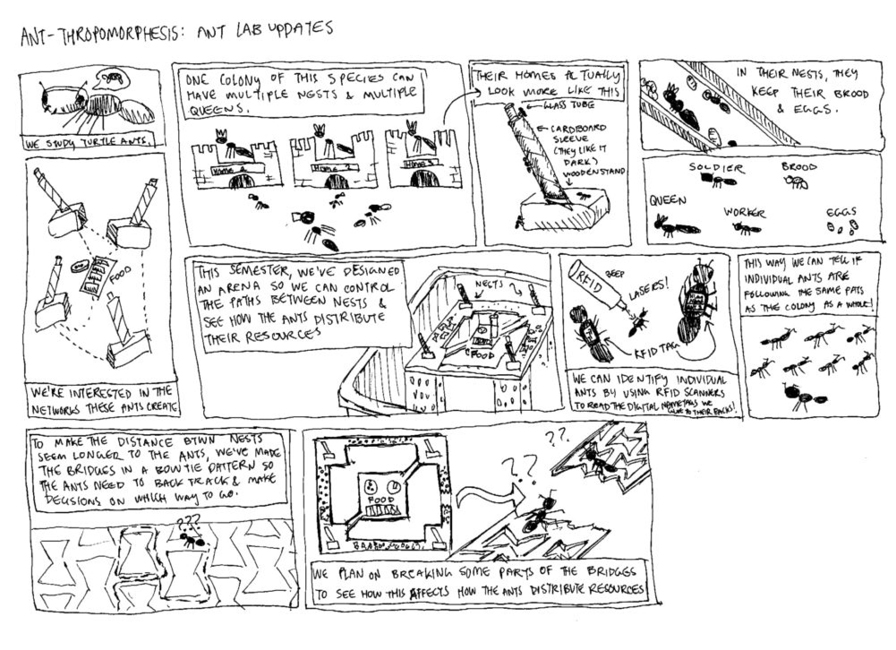Social Animalia
Bee Lab
In biology professor Matina Donaldson-Matasci’s HMC Bee Lab, scientists study how colonies of social insects, such as bees and ants, coordinate group behaviors. “Using a combination of field experiments with honey bees, laboratory experiments with ants, mathematical models and computer simulations, we explore how different types of communication systems are suited to different types of environments and social structures,” says Donaldson-Matasci.
Recent projects in the Bee Lab include field experiments on honey bee foraging, mapping the floral landscape using drones and computer vision, and a combination of lab experiments and simulations of the transportation networks of arboreal ants. When researchers aren’t running an experiment in the lab or collecting data in the field, they can be found in the lab meeting room doing computational projects and attending weekly lab meetings.


Arya Massarat ’20 is working on an automated method for mapping the species of flowering plants frequented by bees in a landscape. “We have drone images of landscapes in which honey bees forage for nectar and pollen,” he says. “My method stitches these images together, uses computer vision algorithms to identify plants within the images and then automatically labels each plant by its species. At large scales, creating the maps that my method produces is difficult to do manually because bees can travel vast distances in search of resources. We hope my method will allow the lab to create many of these maps automatically. This will allow the lab to ask interesting questions about how the layout and composition of the species of plants in a landscape affect the honey bee colonies within it.”
Elena Romero ’20 is working on her senior thesis, which studies turtle ants. “One turtle ant colony often lives in multiple nests at the same time. I am primarily using statistics to investigate how turtle ants allocate colony members to the colony’s different nests,” she says. “I really enjoy getting to work with the data from previous experiments we’ve run in the lab. I find the data to be really interesting and complex. It seems like something new is always popping up.”
This structure, built to hold 10 ant nests, is the latest iteration in a design developed in the Bee Lab. “These ants live in trees, with multiple nests in hollow cavities in twigs,” says Donaldson-Matasci, describing the structure to Bradley Gonmiah ’23 and daughter, Irene. “Each little red tube on a blue stand is a nest mimicking those cavities. The structure is our attempt to mimic the three-dimensional space that the ants have to navigate when walking between nests. We want to know how the possible pathways between nests might affect which cavities the ants choose to nest in and how they use those nests. Do they put all their babies in nests that are easily accessible? Spread them across many nests? Try to put them in places where it’s easy to quickly move them?”
Marylin Roque ’21 is one of the students who designed the multi-nest structure. An engineering major with a strong interest in biology, Roque is enthusiastic about her work. “What could be better than designing something for a biological application?” she says. Roque spent summer 2019 developing the multilevel structure parameters based on field observations, information from previous experiments using earlier versions of the platform and functionality set by experimental needs. After designing the parts of the structure with AutoCAD software, Roque laser cuts them in acrylic. Finally, she glues the pieces together. “The last step is my absolute favorite part of the process,” she says, “because there is a rush of emotion either from knowing that all calculations, hard work and patience paid off, or from realizing that it’s time to go back to step one.”
Bee Lab researchers use tiny radio frequency identification tags to track the ants’ movement with lasers. Ants are anesthetized with nitrogen gas and gently sandwiched in a foam disk with their thorax exposed. With the help of a microscope, the scientist glues the tiny tag, which looks like a single piece of silver glitter, to the ant’s thorax. Tag attached, the sleeping ant is scanned with a laser, activating a circuit on the tag that broadcasts a unique number. The number is automatically added to the colony database.
The nest platforms are placed in “arenas,” where researchers can observe and record ant behavior. Lasers pointed at each nest scan the ants as they enter and exit, recording their movement.
Humans aren’t the only ones having to adjust to online coursework during the COVID-19 pandemic. Donaldson-Matasci brought the turtle ants home with her so that she wouldn’t have to return to the lab to feed them. “So far, it’s not too bad,” she says. “It took a little while to gather up all the things they need and set up a space in my house. But now that’s done, it will actually be easier here. They need to be fed once a week and my daughter, Irene, enjoys helping me.” One change Irene implemented was to rename the colonies.
